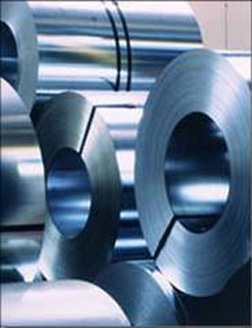Continuous Sheet Galvanizing
Continuous sheet galvanizing is also a hot-dip process, but is only applied to steel sheets, strips, and wire. In a coil-to-coil process, steel sheets from 0.010 to 1.70 inches (0.25 mm to 4.30 mm) thick and up to 72 inches (1,830 mm) wide are passed as a continuous ribbon through cleaning baths and molten zinc at speeds up to 600 feet per minute.
Preparing the steel for the continuous galvanized coating begins with cleaning in an alkaline liquid combined with brushing, rinsing, and drying. Then the steel passes into the heating or annealing furnace to soften it and impart the desired strength and formability. In this annealing furnace, the steel is maintained under a reducing gas atmosphere, composed of hydrogen and nitrogen, to remove any oxide that may be on the surface. Just as in the batch hot-dip process, the steel must be completely clean of oxides and contaminants for a successful coating.

As the steel exits the furnace, it enters into a vacuum chamber, or snout, before entering the molten zinc bath to prevent any air from re-oxidizing the heated steel product. The steel is then sent around a submerged roll in the molten bath to create the bonded coating and removed in a vertical direction. As the product is withdrawn from the bath, precisely regulated, high-pressure air (air knife) is used to remove any excess zinc to create a closely controlled coating thickness. The steel is then allowed to cool and solidify before contacting another roll to avoid transferring or damaging the coating.
Today, this continuous process is used to make seven different types of sheet products including:
- galvanized (zinc)
- galvannealed (90-92% zinc/8-10% iron alloy)
- two alloys of zinc and aluminum (55% aluminum/45% zinc alloy and 95% zinc/5% aluminum alloy)
- two aluminum-based alloys (100% aluminum, 89-95% aluminum/5-11% silicon alloy)
- terne coating (85-97% lead/3-15% tin alloy)
As the name states, this process is only applied to sheet steels. The most common applications are in car bodies, appliances, corrugated roofing and siding, duct work, and culvert pipe. The smooth coating does allow it to be treated for painting, which will increase service life. Because of the relatively thin coating, unpainted continuous sheet galvanizing is recommended for interior applications or where exposure to corrosive elements is mild.
ASTM A653 / A653M Standard Specification for Steel Sheet, Zinc-Coated (Galvanized) or Zinc-Iron Alloy-Coated (Galvannealed) by the Hot-Dip Process governs the coating of steel via the continuous process.
Coating Characteristics
Because both are hot-dip processes, continuous sheet and batch hot-dip galvanizing are often confused. It is important to understand the hot-dip galvanizing process is NOT the same as in-line or continuous sheet galvanizing. One major difference in the two coatings is the thickness. The continuous sheet galvanizing process has greater control and preciseness when it comes to zinc thickness as the air knife used after galvanizing ensures a uniform thickness across the steel sheet. The coating is mostly unalloyed zinc, though minimal alloy layers are present, and is ductile and able to withstand deep drawing or bending without damage. This is important as the coating is applied prior to final fabrication such as punching, bending, and cutting.
Because of the precise control of coating thickness, continuous sheet is stocked in a variety of coating weights. One of the most common zinc coatings is Class G90, which has 0.9 oz/ft2 of zinc (total both sides) or about 0.80 mils (20 ?m) per side.
Service life for all zinc coatings is linear to zinc thickness; however, because the continuous sheet coating is applied pre-fabrication, final forming and placement often includes punching holes, bending, cutting, etc. which creates uncoated areas. Like batch hot-dip galvanizing, the surrounding zinc will provide cathodic protection to these uncoated areas, but as there is much less zinc present, the best practice is to touch-up any exposed areas after fabrication to extend service life.
